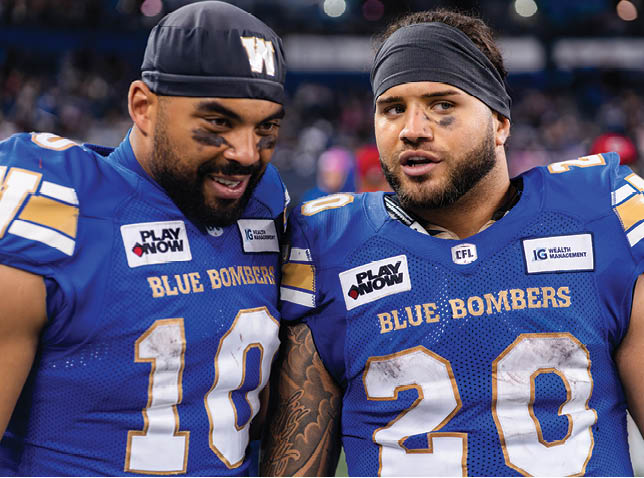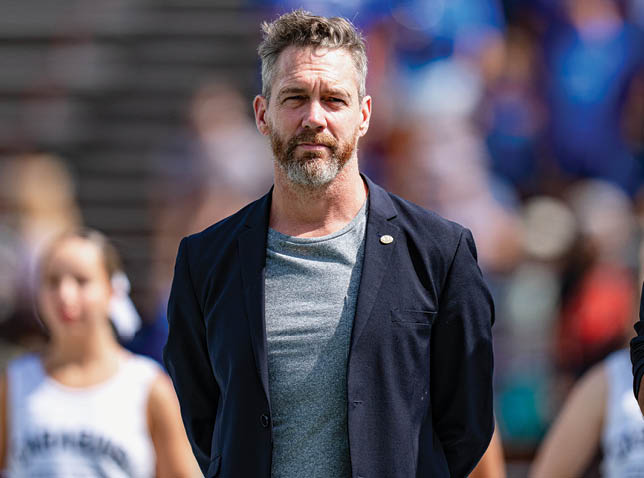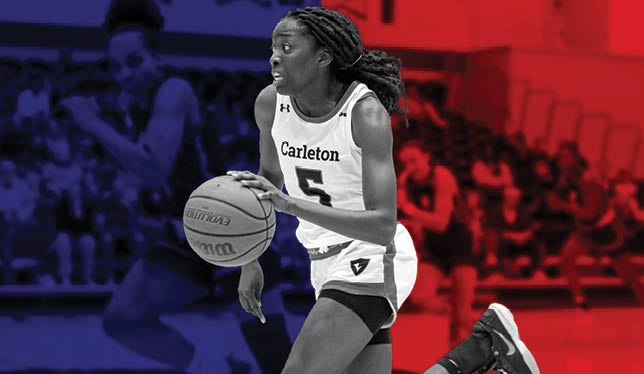Océane Kounkou grew up shooting hoops in Gatineau, Que., with dreams that her basketball skills would earn her a university education and lead to a professional playing career. Her goal was to attend a top program in the U.S. at a National Collegiate Athletic Association (NCAA) member institution, but she was also open to attending a U Sports member university in Canada.
She ended up having both experiences.
Ms. Kounkou spent two seasons soaking up the energy of big crowds while playing at the University of Buffalo, but the business-like approach of the Division I program didn’t meet her expectations for development.
A switch to Carleton University in Ottawa has been the perfect fit. “I was able to get more of a learning curve and build a relationship with my coaches in U Sports,” says the 25-year-old shooting guard, who’s in her third season and final year of eligibility at Carleton.
Ms. Kounkou was one of thousands of Canadian student-athletes who chose a U.S.-based school after excelling in high school. The most recent NCAA statistics show 3,160 Canadians attended top-tier Division I schools in 2021-22, which offer the highest level of competition and the most scholarships. Another 1,248 attended Division II schools that usually give out partial scholarships. Those types of numbers have raised questions over the years about the impact on Canada’s university sports programs.
Is there a talent drain that makes U Sports member universities less competitive? Do NCAA schools deliver better experiences and opportunities? And what’s being done to keep more Canadian athletes at home?
The answers are complicated and are influenced by foundational and financial differences.
The NCAA has more than 1,100 member schools across three divisions, with 500,000-plus athletes competing in 24 sports. Division I accounts for just over 350 schools and 190,000 athletes.
“There certainly is a priority on the balance and ensuring that our regulations, our competitive schedules, are all built with the notion of supporting and encouraging and allowing academic success for our student-athletes. That is a big piece.”
By contrast, U Sports’ 15,500 student-athletes compete at 57 schools in four conferences across Canada.
According to NCAA president Charlie Baker, athletic budgets in Division I can range from US$5 million to $250 million, with 59 schools spending more than $100 million annually and another 32 spending over $50 million. Those figures would be considered pie in the sky for U Sports schools.
“We are at a very small fraction of those numbers. Not even close,” says William Moylan, the director of sports excellence at Université de Montréal. “We are well below the C$5-million range for our entire budget.”
Balancing changes
Canada has a reputation for putting more emphasis on academics than athletics, but U Sports chief executive officer Pierre Arsenault says the system tries to strike a balance.
“There certainly is a priority on the balance and ensuring that our regulations, our competitive schedules, are all built with the notion of supporting and encouraging and allowing academic success for our student-athletes. That is a big piece.”
He adds that “if we focus on academics, it can also be a really high [competitive] and transformative athletic experience. We want to hit the level of quality with both sides of that.”
Mr. Moylan says the U de M aims to give its 550 student-athletes a “global experience” that focuses on three areas: academic success, athletic development and building leadership skills. “When they do exit [university], they’re varsity athletes from a top-quality school, plus they have all of these other leadership training/groups that they’ve been through that will help them be optimal human beings as they go forward.”
Over the years, U Sports has implemented and tested changes to try to keep Canadian student-athletes on home soil. That includes a repatriation rule change in 2014 that no longer punishes Canadians returning to a U Sports school from the NCAA, as well as upcoming changes this fall that eliminates potentially restrictive academic requirements for first-year students. A pilot project also tested increased scholarships for women hockey players. Sometimes, though, it’s hard to change a young person’s mind when they’re inundated with NCAA images of marching bands, cheering crowds and students signing pro contracts.
Individual choices
Ms. Kounkou is one athlete who took advantage of the repatriation rule after her NCAA experience fell short of her expectations.
The rule change eliminated the requirement that Canadian student-athletes returning from an NCAA school had to sit out a year of competition.
Ms. Kounkou, who was born in France, graduated from Dawson College CEGEP in Montreal. She says only one U Sports school showed interest in her so she attended a summer camp at the University of Buffalo. When she was offered a “full-ride” scholarship that covered tuition, fees, books and room and board, she believed it was the right step toward reaching her dream of one day playing pro overseas.
“I went to college with zero debt and I left college with zero debt.”
The Buffalo Bulls were coming off an appearance in the 2018 March Madness national tournament, where they advanced to the Sweet 16. In the 2018-19 season, the squad reached the Round of 32 but as a rookie Ms. Kounkou didn’t play.
“You really understand the entertainment and the value of the money behind the sport when you go to the States,” she says. “The NCAA as a whole is truly a business model and so the approach to the game is completely different.”
That approach, though, has its downside. Players are recruited for specific positions and expected to excel, almost like being at the pro level, she says. Coaches are also focused on results.
“They have to win games to continue to have their next contract. It’s kind of a perspective you don’t get in Canada as much.”
After she went home to Quebec during the COVID-19 pandemic, she decided to switch to a U Sports school. Carleton offered her a full athletic financial award (AFA), U Sports’ version of a scholarship.
AFAs can equal the total of tuition and mandatory fees for a student’s academic year, although conferences can be more restrictive. The Ontario University Athletics conference had its AFAs capped at $4,500 but increased them to $5,000 starting in 2023-24.
Ms. Kounkou, a communications major, covered the rest of her tuition and expenses with a bursary and loan. She went on to help the Ravens women’s basketball team win their 17th U Sports championship title. “The competitiveness and the skill level and fundamentals – there are teams that we could beat in the States,” she says.

Path to the pros
Running back Brady Oliveira and receiver Nic Demski shared the goal of playing pro football, but the Winnipeg-born athletes took different postsecondary paths to get there.
Neither have regrets.
Mr. Oliveira wanted to go to an NCAA Division I school because he believed the high level of play would offer the most opportunities to be seen by National Football League (NFL) scouts. He also needed a full-ride scholarship to eliminate any financial burden on his family.
The University of North Dakota (UND) was the only Division I school to offer him a full ride in 2015. He recalled it was worth more than US$30,000 per year. (Tuition can be double for international students.)
“I went to college with zero debt and I left college with zero debt,” he says.
He finished as the program’s seventh all-time leading rusher but wasn’t drafted by an NFL team. The Winnipeg Blue Bombers then selected him 14th overall in the 2019 Canadian Football League (CFL) draft.
Mr. Oliveira climbed to new heights in 2023. He led the CFL in rushing yards (1,534) and was named the league’s most outstanding Canadian. He was also runner-up for the nine-team league’s most outstanding player award.
Playing at a Division I or II school is a “special opportunity” for a Canadian athlete, he says. “They just have so much more money down there and so much more resources and they put all that money and those resources into their sports programs in these colleges.”
Mr. Demski, meanwhile, ended up attending a U Sports member university. His father drove him to football camps and NCAA schools including the University of Nebraska, University of Minnesota and University of North Dakota (UND). Only UND was committed to making him an offer, but the coaching staff wanted him to be a linebacker. He was initially a quarterback at Winnipeg’s Oak Park High School, then a running back and occasional receiver. “I had never played defence in my life and I told them that I wasn’t really interested in switching, so after that the scholarship talks kind of ended,” he says.
He accepted a full AFA to play for the University of Manitoba Bisons.
“It was kind of the start of more [U Sports players] getting those looks down south [in the NFL] so I just thought I’d take my chances and play up here,” Mr. Demski says.
Bisons coaches targeted his receiving skills and he was drafted sixth overall by the CFL’s Saskatchewan Roughriders in 2015. He played two seasons for the Roughriders before signing with the Blue Bombers in 2018. He had a career-high 1,006 receiving yards in 2023. He and Mr. Oliveira also made CFL history, becoming the first pair of Canadian players to go over 1,000 yards rushing and receiving for the same team in the same season.
“The NCAA as a whole is truly a business model and so the approach to the game is completely different.”
“I’m very thankful for every coach that I’ve crossed paths with,” Mr. Demski says. “At the U of M, they used me right and they were able to help me change positions and basically take my skill set to a different level.”
Even though many top Canadian athletes head south to attend NCAA schools, he doesn’t think it significantly depletes the level of play in U Sports. “There’s still a lot of great talent that is, I use the word sometimes ‘overlooked,’ because sometimes you don’t get the same opportunities and the same exposure that you do playing high school football here,” he says.
When asked what changes U Sports could make to keep more talented athletes in Canada, Mr. Demski pointed to money. “Obviously, it’s a big ask, but the full scholarships [in the NCAA] is a huge thing. A lot of times when people don’t have a lot of money or don’t want to go into student loans or debt, you’re kind of forced to stay at your hometown school so you don’t have to pay for housing and stuff like that.”
The boost in bucks could be flexible, he adds. “It doesn’t have to be every player on the team deserves a full ride, but there should be some capacity of players that could earn a full ride and I think that way you’re going to have more talent spread out across Canada.”
An ‘ethical’ system
Canada’s scholarships are always a talking point.
AFAs can be given to 75 per cent of a sport’s “championship” roster, which produces a cap. That roster is 48 players for football and 12 each for men’s and women’s basketball teams, for example. The cap gets used by units, which is a student’s full-time tuition and fees at their specific school. The tuition average in Canada is $6,834. The breakdown of units is discretionary. If one athlete’s tuition and fees costs $7,000, that’s one unit they could receive. Two teammates could then get AFAs of $4,000 for one and $3,000 for another to use up one more unit.
However, Canadian universities rarely have a full pot of money from funding, donations and fundraising that would enable sports programs to distribute the maximum AFAs they’re allowed.
“Currently, in our system, not all schools are reaching the ceiling of their allowable cap in every sport.” says Mr. Arsenault, who took over as U Sports CEO in June 2022 after 13 years as the director of athletics and recreation at Mount Allison University in New Brunswick.
Mr. Moylan said that’s the case in Quebec even though the average tuition is about $3,800, but he isn’t in favour of adopting the NCAA scholarship model.
“I think it’s a more ethical way of going about doing things, the way we have it here in Canada,” he says. “I’m not saying I’m against what’s in the U.S., but I think what we have going is a good thing. It makes the rules of engagement quite clear. It’s a fair playing field. Nobody has necessarily a competitive advantage over somebody else because they have more alumni or more money or more fundraising.”

Hockey pilot project
In 2014, U Sports launched a five-year pilot project for women’s hockey to see if enhanced AFAs could put a dent in the number of top players going to the NCAA. At the time, it was reported about 400 Canadian women played for NCAA schools. The voluntary project allowed schools to offer AFAs to cover a player’s tuition, fees and room and board. The units were still capped.
The project was extended two more years to gather more data, but membership support wasn’t strong, so it ended as of September 2022. “It was not dramatic, significant change to the point where you could say for sure there was a really valuable cause-and-effect,” says Mr. Arsenault, recalling the number of Canadians playing at NCAA schools at the end of the project was about 375.
According to NCAA stats, there were 305 Canadian women hockey players competing for Division I schools in 2021-22 and 13 in Division II. Figures for Division III, which has teams but doesn’t offer scholarships, weren’t included.
Longtime women’s hockey coach Howie Draper, however, would have liked the pilot project to become permanent. Mr. Draper coached the University of Alberta Panda women’s hockey team for 26 years before taking a leave of absence last fall to become head coach of the New York team in the new Professional Women’s Hockey League. He believes the pilot project helped him recruit four or five highly skilled players because they received enhanced AFAs.
“If we focus on academics, it can also be a really high [quality] and transformative athletic experience.”
“Most of them would have been inundated with offers from stateside schools, so absolutely I think that was something that was in the forefront of their minds,” says Mr. Draper, who guided the Pandas to eight national titles. “What it did is that it provided another option. Before, I think many families and athletes wouldn’t have even considered us as being part of the picture.”
His program didn’t receive any new money but reorganized what it had to cover those enhanced AFAs. He also saw differences on the ice. “What I was able to observe here in [the] Canada West [conference], was our league got stronger. I think our top end became a little deeper,” Mr. Draper says.
The repatriation rule helps bring back Canadian athletes, but Mr. Draper adds it’s important to keep them here in the first place so they don’t decide to make the U.S. their permanent home. “What we focused on at U of A, it’s more athlete-and-person driven. We focus on helping young people grow into leaders and be positive contributors to our society.”
More changes coming
U Sports’ upcoming changes aim to make it easier for young athletes to attend a Canadian university.
Starting for the 2024-25 school year, students entering a member university for the first time can play and receive an AFA as long as they’re accepted and enrolled in a degree-granting program.
That replaces a policy that required students to have an 80 per cent average in their final year of high school or from a Quebec CEGEP as well as maintain a 60 per cent average to be able to get an AFA and play in their first year of study.
“It’s a recognition that not everyone comes from the same background or support network for being able to meet certain academic thresholds,” Mr. Arsenault says.
AFA distribution rules are changing at the same time. A minimum of 45 per cent of a school’s total AFA units will have to go to athletes on men’s teams and a minimum of 45 per cent for women’s teams. The other 10 per cent is discretionary.
“You see the investment in professionalization of coaching, you see the investment of support services for student-athletes, you see the investment in facilities and training areas that are rivalling other systems,” Mr. Arsenault says. “That’s the opportunity we have, is to just make it as attractive as possible for Canadians to want to play in U Sports.”

Excellent article. Very informative. Judy always does a great job of getting the facts and making it easy to read for readers